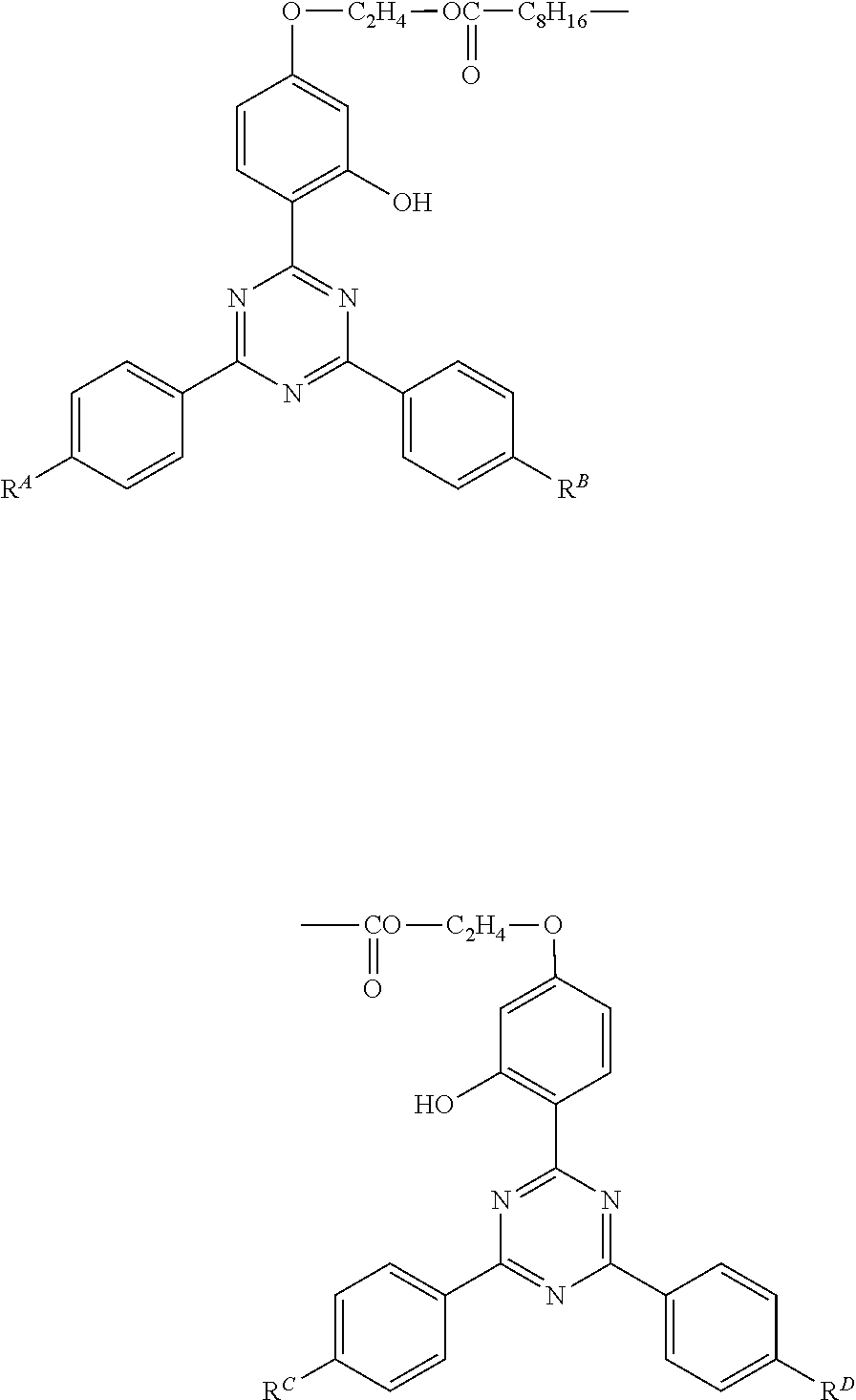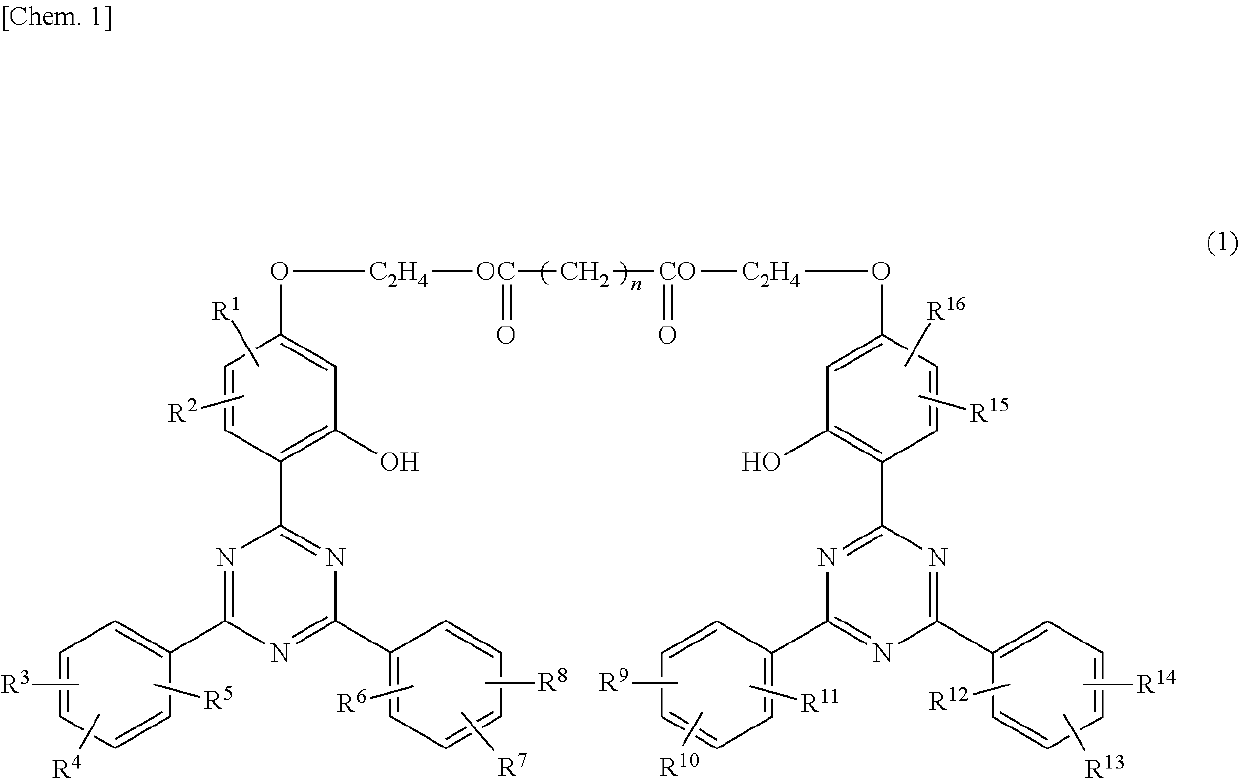Resin composition
a technology of composition and resin, applied in the field of resin composition, can solve the problems of insufficient resistance to volatilization and heat, poor heat resistance, reduction in efficacy and contamination of processing equipment, etc., and achieve the effects of high melting point, reduced molding properties, and high melting poin
- Summary
- Abstract
- Description
- Claims
- Application Information
AI Technical Summary
Benefits of technology
Problems solved by technology
Method used
Image
Examples
synthesis example 1
nd No. 1-1
[0118]A 1000 ml five-necked flask was fitted with a stirrer, a nitrogen inlet, a thermometer, a fractionating column, and a stopper (for sampling), and the top of the fractionating column was fitted with a distilling receiver and a condenser. The system thus provided was used as a reaction equipment. In the flask were put 86 g (0.2 mol) of 2-[2-hydroxy-4-(2-hydroxyethyloxy)phenyl]-4,6-diphenyl-1,3,5-triazine as an alcohol component (a starting material), 20 g (0.1 mol) of sebacic acid as a dicarboxylic acid component (another starting material), 300 g of xylene as a solvent, and 0.2 g (1 mmol) of sodium p-toluenesulfonate monohydrate as an esterification catalyst, and heated at 130° C. under atmospheric pressure to conduct esterification reaction while driving produced water out of the reaction system. The esterification reaction was ceased when the starting materials reduced to less than 1% as analyzed by HPLC. The reaction mixture was worked up by cooling for crystalliza...
synthesis example 2
nd No. 2-1
[0119]An esterification reaction and working-up procedures were carried out in the same manner using the same reaction equipment as used in Synthesis Example 1, except for replacing the starting dicarboxylic acid component with 23 g (0.1 mol) of dodecanedioic acid, to prepare Compound No. 2-1, which is one of Compound No. 2 in which RA, RB, RC, and RD are all hydrogen. Identification of the product was carried out in the same manner as in Synthesis Example 1. The retention time of the desired product was 30.4 min.
synthesis example 3
nd No. 2A-1
[0120]An esterification reaction and working-up procedures were carried out in the same manner using the same reaction equipment as used in Synthesis Example 1, except for replacing the starting alcohol component with 88 g (0.2 mol) of 2-[2-hydroxy-4-(2-hydroxyethyloxy)phenyl]-4,6-bis(2,4-dimethylphenyl)-1,3,5-triazine, to prepare Compound No. 2A-1, which is one of Compound No. 2A in which RA1, RA2, RB1, RB2, RC1, RC2, RD1, and RD2 are all methyl. The product was identified in the same manner as in Synthesis Example 1. The retention time of the desired product was 27.6 min.
PUM
| Property | Measurement | Unit |
|---|---|---|
| melting point | aaaaa | aaaaa |
| melting point | aaaaa | aaaaa |
| melting point | aaaaa | aaaaa |
Abstract
Description
Claims
Application Information
 Login to View More
Login to View More - R&D
- Intellectual Property
- Life Sciences
- Materials
- Tech Scout
- Unparalleled Data Quality
- Higher Quality Content
- 60% Fewer Hallucinations
Browse by: Latest US Patents, China's latest patents, Technical Efficacy Thesaurus, Application Domain, Technology Topic, Popular Technical Reports.
© 2025 PatSnap. All rights reserved.Legal|Privacy policy|Modern Slavery Act Transparency Statement|Sitemap|About US| Contact US: help@patsnap.com



